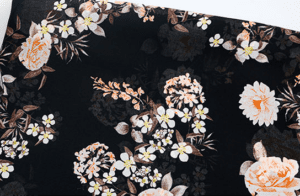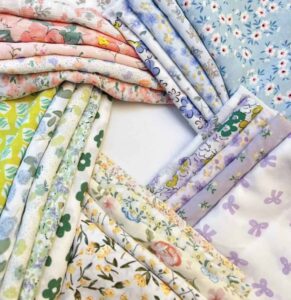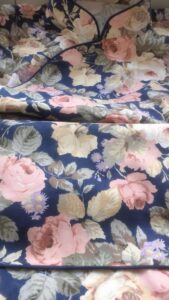The first thing a digital printing equipment company understands is what kind of product it wants to make, then determine the process, then choose the printhead, then design and manufacture the equipment according to the properties of the process and the printhead, after 50,000-100,000 metres of actual production testing, so that the equipment is the digital printing equipment that can stand up to scrutiny. For example, we have developed a digital printing system for plush velvet, because the printing system for velvet needs to be compatible with the textile printing and dyeing process; there is an urgent need for this in the velvet industry. There are two existing methods of printing on pile: pre-pile printing and post-pile printing. Pre-shaker printing: after the shaking process, the pattern becomes blurred; post-shaker printing: after the shaking process, the pattern is printed on a flat or circular screen, which causes the problem of infiltration (the pattern does not penetrate to the root of the fabric and reveals white). After three years of technical exploration and about a year of technical integration and development, we have now completely solved the problem of digital printing on shaker velvet. This requires a combination of printhead technology and traditional printing processes, otherwise there is no way to do it. So many people will ask what kind of impact does the digital printing of velvet have? The main reason for this is that it is mainly used for outdoor insulation, outdoor clothing and air-conditioned blankets. The main reason for this is that the printed pattern is single and the fabric is mainly monochrome, with no fine and beautiful printing.
So this is how I understand it, the printheads determined the positioning of digital printing in the market. For example, if the Epson printheads were used on imported machines, they could only be used for proofing (the market was small, the printhead companies would not have made any major improvements, and the imported equipment was not specialised in this type of equipment), and Epson would not have made any major improvements to this technology at the beginning of digital printing. But if the Epson printhead meets the domestic machine with the existing imported machine, we can all see that the textile digital printing market is now hitting the paper, reactive printing and acid printing, which has become mainstream after about 8 years of growth. A large proportion of the Epson printheads on domestic equipment are cracked, and the chain reaction begins: the cracking makes the cost of making domestic digital printing equipment relatively low; the price of imported equipment follows.
the cost to the user is significantly reduced, coupled with the improved stability of the Epson printhead technology, the ink for the Epson printhead is becoming more and more stable, and the cost is getting lower and lower, reducing the cost of traditional printing, which has contributed to the rapid development of the digital printing industry. The position of digital printing in the entire printing and dyeing industry has changed from that of a technical face of the dyeing factory to that of a small-volume printer and a fine printer. The whole process is not about which company or individual dominates the development of the industry, it is an organic whole that determines the development of the industry itself. The trigger for the development of the whole industry is the printhead, digital because of Epson printheads, but digital printing and textile printing is a large industry dynamic, and ultimately what kind of printheads and equipment will play a key role in the development of the industry, we are working hard, the industry market will test everything. But one thing is for sure, no matter who it is, the cause must be the printheads, and the choice of printheads will determine the status of the industry.
In fact, the rise of industrial-grade printheads should be attributed to the promotion and development of the advertising industry, the advertising industry from large-format painting jumped to airbrushing, and has been a significant development, so the advertising printing industry in the inkjet technology has been developed to the extreme, the vast majority of advertising equipment manufacturing enterprises early in the use of industrial-grade printheads. As the advertising industry entered the digital printing industry, the use of industrial printheads in the digital printing industry also emerged. If the industrial printheads are combined with the existing Epson printhead technology and the development of domestic and imported equipment, digital printing will rise to another level in the market. The two types of printheads are not mortal enemies, but rather symbiotic brothers, which at this stage means that they will be able to meet the needs of some medium volume production.this has had an impact on the entire textile industry, which in turn has affected the product landscape, with smaller and smaller orders and faster response times.
For example, after the post-80s and post-90s have become the mainstay of society, they have high requirements for personalisation of clothing (clothing and accessories), which has led to a sharp decline in the printing and dyeing industry from orders of tens of thousands or even hundreds of thousands of metres for a pattern to orders of only about 5,000 metres or 10,000 metres now. Digital printing is better, more responsive and less costly. The point is that the industry has been forced to change by digital technology in terms of performance versatility and time costs, and when the demand side changes, digital printing will enter a period of accelerated growth. It will take 10 years from the start of Epson to the initial reception of the industry, 6 years from the beginning of the industry to the change in demand and production patterns, and then only 4 years for the whole pattern to change even faster. So what we have to do is to follow the industry, choose the right things and find the right partners.
I can’t make predictions about the future, but I can share the situation with Lynx Digital: we will need to have more sophisticated and improved industrial printheads. At this stage we are focusing on the Starlight 1024 printhead because it can be dismantled, so it has a relatively long life. We have calculated that the Starlight 1024 printhead will work for about three years and that its average cost of use (for a fabric width of 1.5 metres) is about $0.10 per metre or less. Other printheads may offer some better performance than the Starlight 1024, but the cost of use may be a little higher. The choice must be a painful one, with fineness, control, colour vibrancy and durability all being indicators of how good a printhead is.
The current situation in the digital printing industry is: improved industrial printheads and Epson printhead technology, together with domestic equipment manufacturing technology, which pretty much determines the status of our digital printing in the whole printing and dyeing industry – although not the main character, but is gradually turning into the main character of this stage. If the single-pass machine is very stable in the future (it needs to be verified for a long time), digital printing will definitely take the lead, which is also in line with the development of the printing industry.
The printing and dyeing industry began with hand-dyeing, tie-dyeing, bluing and batik, with machine dyeing (using industrial dyestuffs) and printing with Heidelberg roller printing machines in the early days.
The printing process is actually very difficult and there is a certain period of time for each upgrade process. Therefore, the position of digital printing in the industry depends on the development of printheads and the extent to which the printing and dyeing process is compatible with digital printing.
A breakthrough in the pure print function of digital printers
Will the printing and dyeing industry be digitalised? The answer is definitely that it will be digitised. As you know, the colour separation systems in the printing and dyeing industry, such as the open source colour separation system, and the colour separation system made by Honghua, including the titration system, are actually examples of the digitalisation of the printing and dyeing industry, only that digital printing is more costly and has more replacement links.
Digital printing is on-demand printing and all the ink is controllable, so you can calculate how many drops of ink fall in a square inch, which is the best value for colour, and this is the best way to save dyes. We have already started to prepare how to solve the problem of how to achieve a critical process and system without floating colours, so that the whole printing and dyeing industry can achieve waterless printing and digital printing.
Another question is whether digital printing technology can be upgraded. I studied printing and dyeing myself and I have worked with many veteran printers and we have been discussing this issue. We have been discussing this issue the digital foil stamping machine, which scrapes the traditional foil stamping paste first, makes a precise positioning and then prints within the curves of the paste with digital printing. Once this can be done, it solves a lot of problems in the process, for example, we originally used flat and circular screens to make the stamping paste and then to do it on the stamping machine, because we have industrial grade printheads, such as the Starlight 1024 printhead, we can match the traditional printing process to make some new machines, in order to break through the original digital printing machine is only the function of printing patterns.
For example, we can upgrade all our screen and flat screen printing machines, for example, if the screen and flat screen are 10 colour sets, you can give me a workstation and I can add a digital printing machine to it. In this way, many of the advantages of your traditional printing are retained, and digital printing can also do something that combines digital printing with traditional printing. Because digital printing has always been a weakness in printing solid colours, whereas printing solid colours is the strength of traditional screen printing. If you combine the strengths of traditional screen printing with the fineness of digital printing, this could be a breakthrough.
This is what sets us apart from other digital printers, as we are a digital printing machine with a matching process.
In the beginning, the printing and dyeing industry felt that it did not matter because our screen printing was well developed and so was the plate making industry, with screen making machines and exposure machines, and the number of orders was very large; while the digital printing machines only printed 2 square metres per hour, so everyone felt that it did not matter. However, when digital printing technology develops further, the industry orders become smaller and the time required becomes faster, the printing and dyeing industry has no choice but to accept passively, because everyone is using digital printing machines to make samples and produce small orders, the whole industry can only accept passively.
With the increased stability of our digital printing machines, including the gradual reduction in order production, garment customers now operate as follows: they need two to three hundred metres of fabric up front, and when they have made the garment and sold it, they can determine the amount of replenishment and ask the fabric supplier to supply it at any time. The garment customer does not have the same stock and inventory as before, and the fabric merchant does not keep a large number of the same patterns in stock. So later on, the whole industry becomes proactive and they tell a lot of customers that I can supply a lot of different types of digital printing. So, the whole printing and dyeing industry started out with nothing, but later on they gradually demanded different printheads.
























